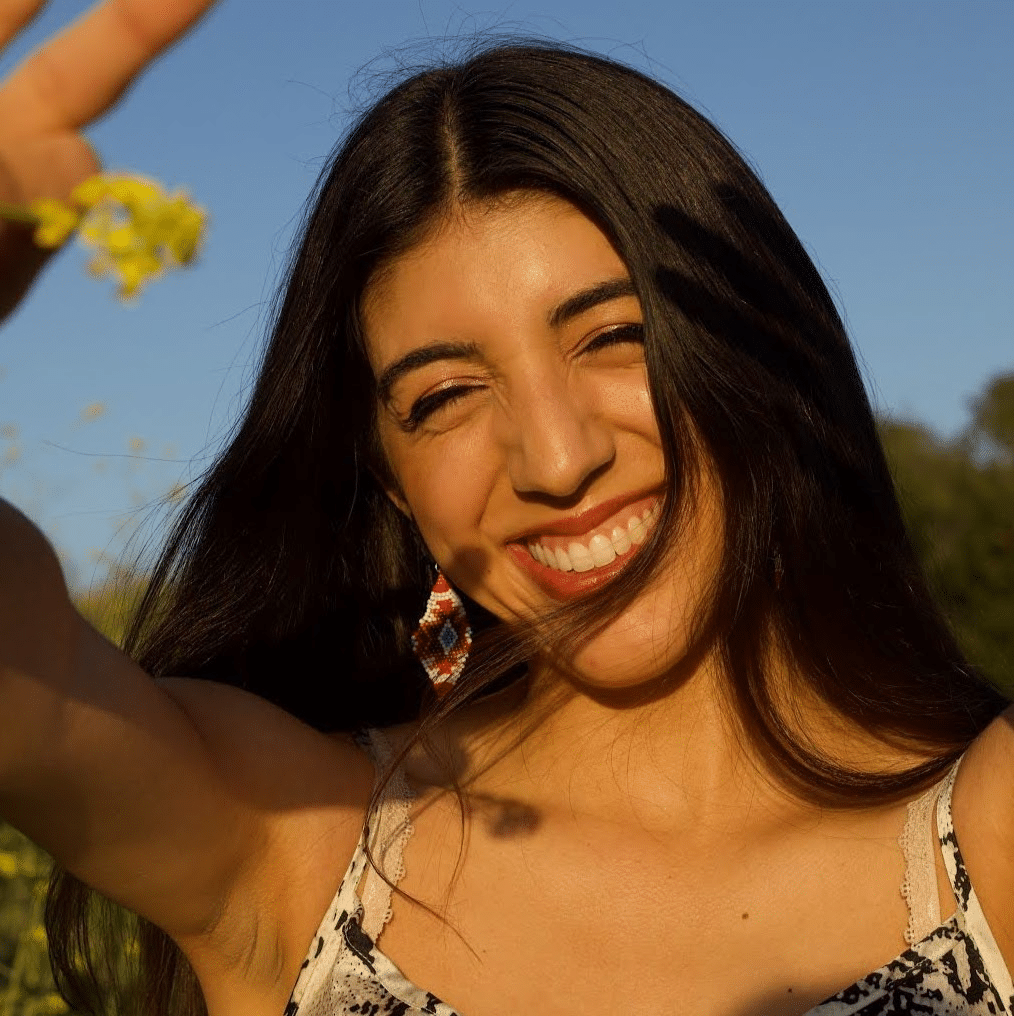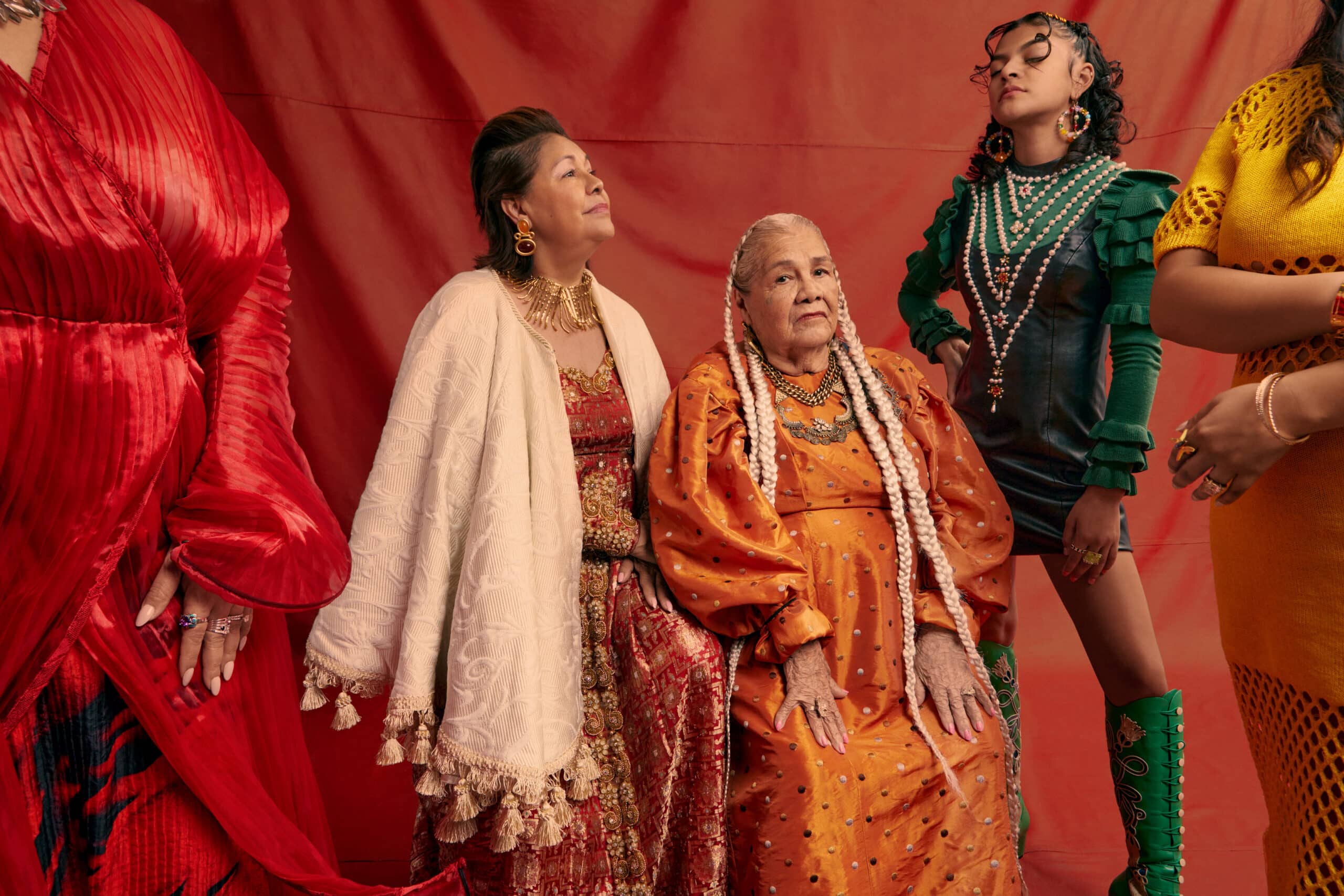Kannst du dich vorstellen und erzählen, wie du zur Fotografie gekommen bist?
Mein Name ist Brittany Bravo. Ich bin eine Fotografin aus Los Angeles und in dritter Generation Angelino. Meine Familie lebt also schon lange in L.A. und ich bin sehr stolz darauf, aus L.A. zu sein.
Ich begann mit der Fotografie, als ich in der Mittelschule war. Meine Mutter schenkte mir und meiner kleinen Schwester zu Weihnachten eine kleine rote Point-and-Shoot-Kamera - wir waren so begeistert davon. Es war ein gemeinsames Weihnachtsgeschenk, und wir spielten den ganzen Tag damit. Wir machten Fotos von unseren Nachbarn, die mit ihren Fahrrädern durch Pfützen fuhren, und zwangen sie, das immer wieder zu tun. Dann sahen wir, wie das ganze Wasser auf den Bildern in der Luft um ihr Fahrrad herum gefror. Und wir dachten: "Wow, das ist so cool. Oh mein Gott, wir haben das Wasser auf dem Foto gefroren!"
Ich dachte, das sei das Tollste, was es gibt. Wir zwangen unsere Cousins, in unseren kleinen Filmen mitzuspielen, denn die Kamera konnte auch Videos aufnehmen. Meine Schwester und ich stritten uns, wer der Regisseur war und in welche Richtung wir gehen sollten - wir waren buchstäblich kleine Kinder, die sich darum stritten, wer der Regisseur ist. Wir blieben die ganze Nacht auf, um den Film mit Windows Movie Maker zu bearbeiten, und ließen dann alle Tanten und Onkel und unsere Eltern den Film am Ende ansehen.
Für uns war es einfach eine Möglichkeit, Spaß zu haben und unsere Welt zu erkunden, und es hat uns auch wirklich zusammengeschweißt. Jetzt sind wir beide Fotografen - meine Schwester macht E-Commerce-Fotografie. Sie unterstützt mich bei vielen meiner persönlichen Projekte - sie ist fast immer dabei. Sie hat früher viel getanzt, Hip-Hop und Lyrik, deshalb kann sie sich sehr gut Posen ausdenken.
Sie dreht hauptsächlich Filme für ihre eigene Arbeit und bringt ihre Filmkamera mit, wenn sie hilft - wir stehen uns sehr nahe und arbeiten sehr gut zusammen, und sie bringt definitiv ein zusätzliches Element in meine persönlichen Projekte ein. Ich finde es wirklich cool, dass wir beide Freude und Spaß daran gefunden haben, und ich glaube, dass es uns auch heute noch Freude und Spaß bereitet.
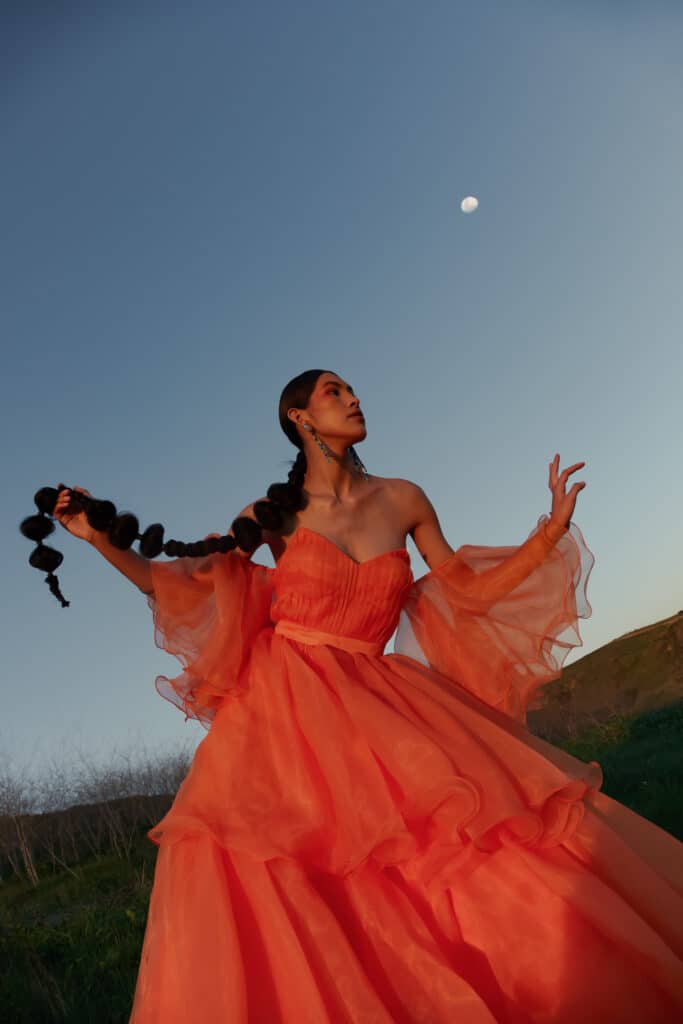
In deiner Biografie erzählst du, dass du ein Angelino der dritten Generation mit Chicana-Wurzeln bist. Wie wirkt sich das auf deine Ästhetik in deinen persönlichen Projekten aus?
Die dritte Generation mit chicanischen Wurzeln hat einen großen Einfluss auf meine Ästhetik. Ich nehme viel von der Ästhetik meiner Gemeinschaft und Kultur mit. Los Angeles ist vor allem für die Chicano-Kultur bekannt.
Es ist wirklich cool, alte Fotos von meinen eigenen Familienmitgliedern anzuschauen und meinen Vater und meine Tante und ihre Teenager zu sehen, mit dem Lipliner und den ganzen Outfits und allem. Ich liebe es, diese Ästhetik in meiner Arbeit zu ehren, aber auch wirklich kreativ zu sein. Ich liebe den Begriff "Indigener Futurismus".
Für mich geht es darum, die Traditionen deiner Kultur aufzugreifen und trotzdem fantasievoll und kreativ damit umzugehen, denn Kultur ist etwas so Lebendiges, das sich jeden Tag weiterentwickelt und verändert. Und ich denke, wir sind hier, wir sind lebendig, wir sind jetzt hier, wir existieren immer noch. Es geht also darum, Traditionen und traditionelle Ästhetik aufzugreifen und Spaß daran zu haben.
Das kann so aussehen, als würde man die Trenzas, die Teil der mexikanischen, mexikanisch-amerikanischen und indigenen Haar-Ikonographie sind, 10 Fuß hoch machen - bis zum Boden. Die Symbolik wird so richtig deutlich und es ist fantasievoll und in gewisser Weise unwirklich. Es ist mir sehr wichtig, meine Kultur in meiner Arbeit zu ehren, und das hat sich definitiv auf das Styling und die Haare in meinen Bildern ausgewirkt, und auch auf die Talente, mit denen ich zusammenarbeite.
Eine Sache, die mir wirklich wichtig ist, ist es, meine Gemeinschaft auf ein Podest zu stellen und die Leute mit Ehre und Respekt zu fotografieren, um zu zeigen, wie schön, stark und kraftvoll meine Gemeinschaft und Kultur sind. Ich mache meine Arbeit für Menschen wie mich und für meine Gemeinschaft, damit wir sie ansehen und sagen können: "Ja, wir sind wunderschön, wir sind toll und niemand kann mir jemals etwas anderes erzählen. Egal, welche Lebenserfahrungen ich mache, niemand kann mir diesen Stolz nehmen."
Du betreibst sowohl eine persönliche als auch eine gemeinschaftliche Praxis. Siehst du diese beiden Tätigkeiten als getrennt oder verbunden?
Für mich ist beides wichtig. Die Auftragsarbeit hilft mir, die persönliche Arbeit zu unterstützen und zu finanzieren, und die persönliche Arbeit bringt weitere Auftragsarbeiten mit sich. In gewisser Weise befruchten sie sich gegenseitig. Ehrlich gesagt liebe ich beides gleichermaßen, beides macht mir wirklich Spaß.
Auftragsprojekte fordern mich heraus und bringen mich dazu, neue Wege einzuschlagen und mich zu lehren, wie man wirklich kooperativ ist. Bei meiner persönlichen Arbeit kann ich mich nach Herzenslust austoben und die Dinge machen, die ich schon immer machen und in der Welt sehen wollte, und das hört nie auf. In meinem Kopf gibt es immer so viele weitere Fotos - was ich in die Welt gesetzt habe, ist nur die Spitze des Eisbergs.
Das Tolle daran ist, dass sich die Leute zu mir umdrehen und sagen: "Ich liebe die Fotos mit den zehn Fuß langen Zöpfen. Das ist fantastisch. Könntest du meine Vitaminmarke fotografieren?" Die Leute beauftragen mich wegen meiner Fähigkeit, eine Verbindung zu den Talenten herzustellen und das Gefühl der Freude, des Stolzes und des Respekts in meinen Motiven zu wecken, auch wenn das Styling und die Ästhetik meiner persönlichen Arbeit völlig anders ist als die der Auftragsarbeit.
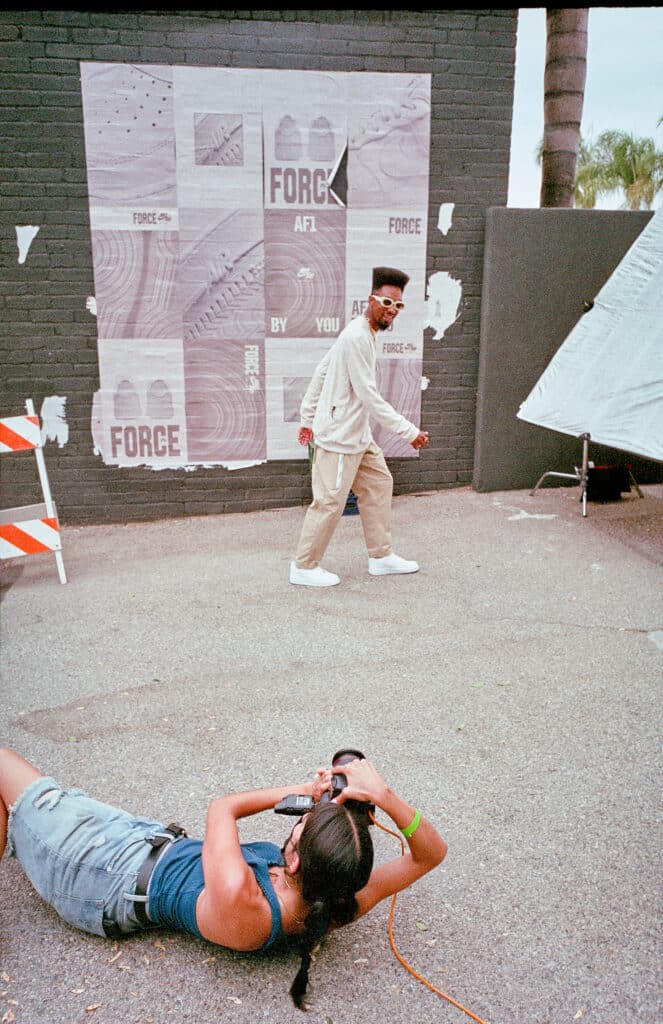
Wie bist du dazu gekommen, diese Art von Auftragsarbeit zu machen?
Ich habe mit der Auftragsarbeit angefangen, indem ich mich vernetzt habe, viel recherchiert habe, viele Podcasts gehört habe und mir angeschaut habe, was man laut Fachleuten tun muss, um von diesen Kunden wahrgenommen zu werden.
Ich bin Mitglied in Fotografenverbänden und -organisationen geworden und habe versucht, meinen Namen in Verzeichnissen wie Foto diversifizieren-und dann hörte ich, dass Portfoliobesprechungen eine tolle Möglichkeit sind, Leute persönlich kennenzulernen, also begann ich, mich für Portfoliobesprechungen anzumelden.
Portfoliobesprechungen sind eine der besten Möglichkeiten, um potenzielle Kunden kennenzulernen - viele der großen Kunden, mit denen ich anfangs gearbeitet habe, habe ich durch diese Besprechungen kennengelernt. Sie sahen meine Arbeit und ich war noch ziemlich unerfahren, aber sie waren bereit, mir eine Chance zu geben, weil sie das Potenzial meiner Arbeit erkannten.
Ich habe auch E-Mail-Newsletter verschickt und ich habe sogar - ich weiß, dass viele Leute sagen, das sei altmodisch - kleine Postkarten an potenzielle Kunden verschickt. Ich bin auf LinkedIn gegangen und habe eine Reihe von Leuten gefunden, die in den Unternehmen arbeiten, für die ich shooten wollte, wie zum Beispiel Target. Dann ging ich auf die LinkedIn-Seite des Unternehmens, um zu sehen, wie ihre Adresse lautet. Ich dachte: "Ich habe keine Ahnung, ob diese Person tatsächlich in der Zentrale arbeitet oder nicht, aber ich werde es trotzdem versuchen, ihr zu schicken. Und drücke die Daumen, dass sie ankommt."
Kürzlich traf ich jemanden persönlich, dem ich einen Flyer geschickt hatte, und sie sagte: "Oh mein Gott, du hast mir vor drei Jahren einen Flyer geschickt, der mir so gut gefallen hat, dass ich ihn an mein ganzes Team geschickt habe!" Das Lustige daran ist, dass ich jetzt oft mit diesem Kunden zusammenarbeite. Er ist sehr rücksichtsvoll, eine große Marke und ich habe in den letzten zwei Jahren sechs Mal mit ihm gearbeitet. Das kam alles dadurch zustande, dass ich ihr diesen einen Flyer schickte und sie ihn an das Team weiterleitete, das mich ursprünglich eingestellt hatte. Selbst wenn es nur bei einer Person funktioniert hat und ich fünfzig davon verschickt habe, hat sich die Arbeit gelohnt.
Traditionelle Marketingmethoden, um deine Arbeit an potenzielle Kunden zu bringen, können immer noch von Vorteil sein; es ist das Risiko wert. Es ist das Risiko wert. Und es macht auch Spaß, weil du deine Arbeit dann ausdrucken kannst und es eine tolle Erfahrung ist, wenn du sie anfassen kannst, statt sie nur digital zu machen. Auch wenn es dir nicht sofort etwas bringt, so pflanzt du doch Samen, und Bäume wachsen nicht über Nacht.
Ich habe jetzt eine Künstlervertretung, aber das hat meinen Wunsch, mich zu vernetzen und meine eigene Karriere in gewisser Weise voranzutreiben, nicht gebremst. Ich denke immer noch: "Wie kann ich meine Arbeit greifbarer und persönlicher machen, vor allem in einer so digitalen Welt?" So kann man sich von anderen abheben.
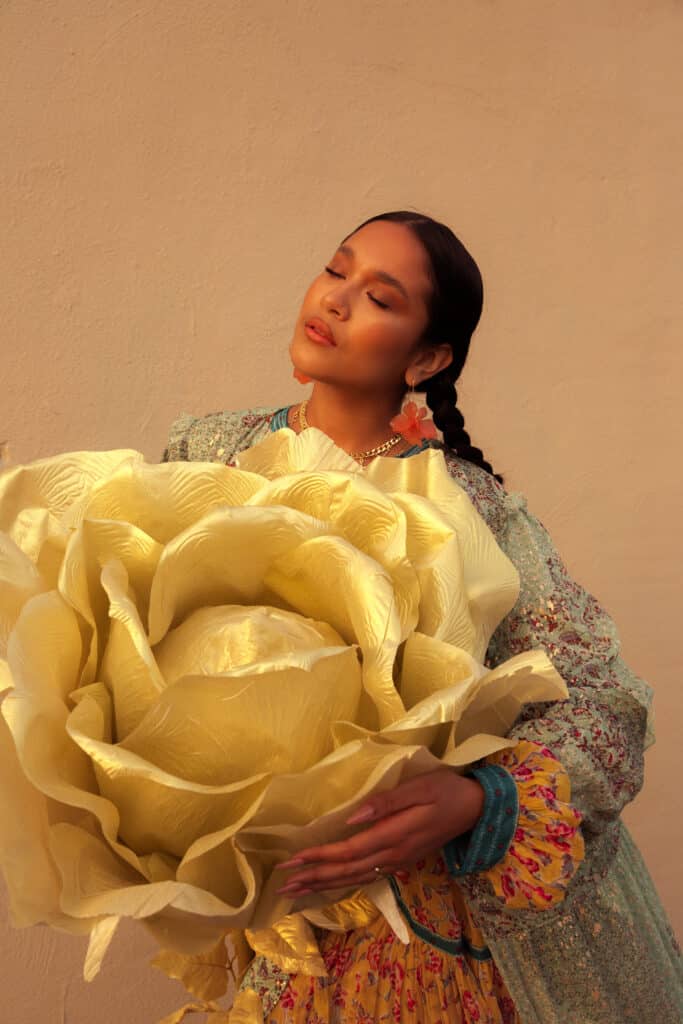
Wo findest du Portfoliobewertungen?
Die erste Portfolioprüfung, die ich je gemacht habe, war durch Palm Springs Foto Festival. Dann habe ich auch eine über Diversify Photo gemacht. Ich habe die Amerikanische Fotokünstler-du kannst für eine Mitgliedschaft bezahlen - und du kannst sie über Focus On Women bekommen.
Viele Fotografenorganisationen und -verbände bieten Portfolioprüfungen an, für die du bezahlen kannst. Sie sind natürlich teuer, also habe ich zu Beginn meiner Selbstständigkeit dafür gespart und sie mir dann geholt. Im Laufe der Zeit war es dann zum Glück weniger belastend, sie selbst zu machen. Ich weiß, dass es für viele Leute unerreichbar ist - manchmal gibt es kostenlose Kurse für BIPOC oder aufstrebende Künstler und du musst dich nur dafür bewerben oder fragen, ob es einen Rabatt gibt oder ob sie kostenlose Kurse anbieten - du wirst vielleicht überrascht sein, was sie sagen.
Gibt es noch andere kostenlose Ressourcen, die du sehr hilfreich fandest oder immer noch nutzt?
Ein Podcast, den ich hilfreich fand, als ich anfing, war Liebe Kunstproduzentin, lieber Kunstproduzent. Die Welt der kommerziellen Arbeit erschien mir sehr geheimnisvoll, und ich war mir nicht sicher, wie sie überhaupt funktioniert. Ich fragte mich: "Was ist das eigentlich? Wer sind Kunstproduzenten? Was ist ein Art Director, ein Creative Director und so weiter. Mir gefiel es, weil sie verschiedene Leute interviewten, die in diesen Rollen arbeiteten - sie sprachen über ihre Perspektive, wie sie ihre Karriere begonnen hatten und was sie in ihren Agenturen tun. Das hat mir geholfen zu lernen, wie ich ein besserer kreativer Partner am Set sein kann.
Ein Podcast, den ich jetzt gerne höre, ist Fotofriedhof-Sie ist von und für arbeitende Fotografen. Sie interviewen Werbefotografen oder andere Fotografen und erzählen von ihrem Weg, was für sie im Moment funktioniert und welche Art von Arbeit sie machen. Es macht einfach Spaß, ihnen zuzuhören - ich habe das Gefühl, dass ich einen kleinen Einblick in ihre Welt bekomme.
Welchen anderen Rat würdest du aufstrebenden Fotografen geben, die gerade mit der kommerziellen Fotografie beginnen?
Der Rat, den ich aufstrebenden Fotografen geben würde, ist, dich selbst und deine Vision immer zu ehren. Lasst euch davon leiten, sowohl bei euren persönlichen Arbeiten als auch bei Auftragsarbeiten. Ich denke, je mehr du dir bei beiden Arten von Arbeit selbst treu bleibst, desto mehr Arbeit wirst du bekommen und desto erfolgreicher wirst du auch bei der Erstellung dieser Arbeit sein.
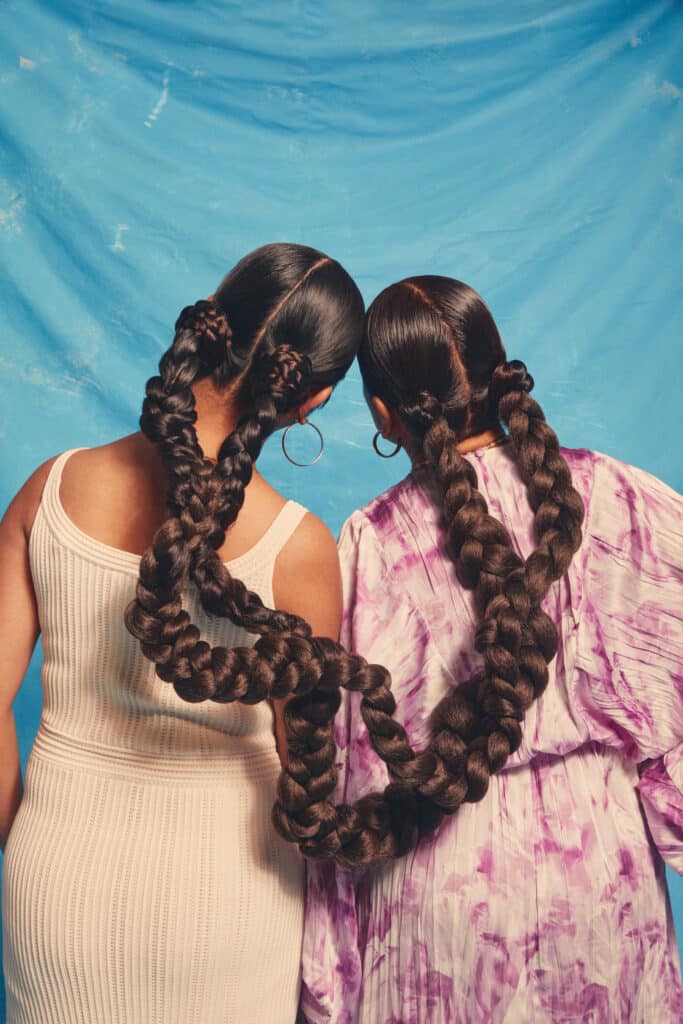
Was hat dich dazu veranlasst, einen Atelierraum zu schaffen?
Wie bei allem anderen auch, waren es kleine Schritte. Zuerst drehte ich in einem winzigen, winzig kleinen Lagerraum, als ich ein Studio brauchte. Dann bekam ich eine Künstler-WG, die wiederum sehr klein war. Da ich als Freiberufler viele Produktaufnahmen machte, brauchte ich einen Raum, in dem ich drehen konnte, ohne immer ein Studio mieten zu müssen.
Nach und nach wurde der Raum größer und größer. Die Miete wurde höher und höher, aber es machte Sinn, es so zu machen. Als meine Karriere wuchs, wuchs auch die Größe des Studios und der Platz. Und jetzt habe ich ein kleines Fotostudio, Bravo StudiosIch wohne im Kunstbezirk Boyle Heights. Meine Schwester hilft mir manchmal beim Putzen oder Aufschließen, wenn ich keine Kapazitäten habe, um Mieter ins Studio zu lassen.
Ich mache nur noch selten Auftragsarbeiten in meinem Studio. Vor allem, weil ich es liebe, Haar- und Make-up-Elemente auf den Fotos zu haben - das Anbringen von Zopfverlängerungen, die drei Meter lang sind, dauert viele Stunden. Es ist also wirklich schön, einen Raum zu haben, in dem ich das machen kann.
Du arbeitest mit Los Photos zusammen. Kannst du uns etwas über diese Organisation erzählen?
Ich war früher Freiwilliger bei Las Fotos Projekt Sie ist eine Organisation, die sich der Betreuung von jungen Fotografinnen und Fotografen aus farbigen Gemeinschaften widmet. Ich war drei Jahre lang Mentorin bei dieser Organisation - eine wirklich tolle Erfahrung. Im Grunde genommen geben sie den Schülern einen kostenlosen Fotokurs für ein Semester, eine Kamera für das Semester und sie bringen die Schüler mit Fachleuten aus der Branche wie mir als Mentoren zusammen. Wir gehen jede Woche mit ihnen in den Unterricht und helfen ihnen, ihre Abschlussprojekte fertigzustellen. Am Ende des Semesters findet dann eine Ausstellung statt, bei der alle Arbeiten der Schüler/innen gezeigt werden; ihre Familien, Freunde und Bekannten kommen und machen Fotos und sind stolz auf sie.
Ich glaube nicht, dass es das Ziel ist, die nächste Generation von Fotografen auszubilden, auch wenn das für viele der Schüler ihr Karriereziel ist, aber es geht wirklich darum, die Fotografie als eine Möglichkeit zu nutzen, uns selbst zu stärken, uns auszudrücken und uns für unsere Gemeinschaften einzusetzen. Es ist ein wirklich starkes Programm, voller Freude, Positivität und Schwesternschaft, und ich habe es wirklich genossen, dort als Mentorin zu arbeiten.
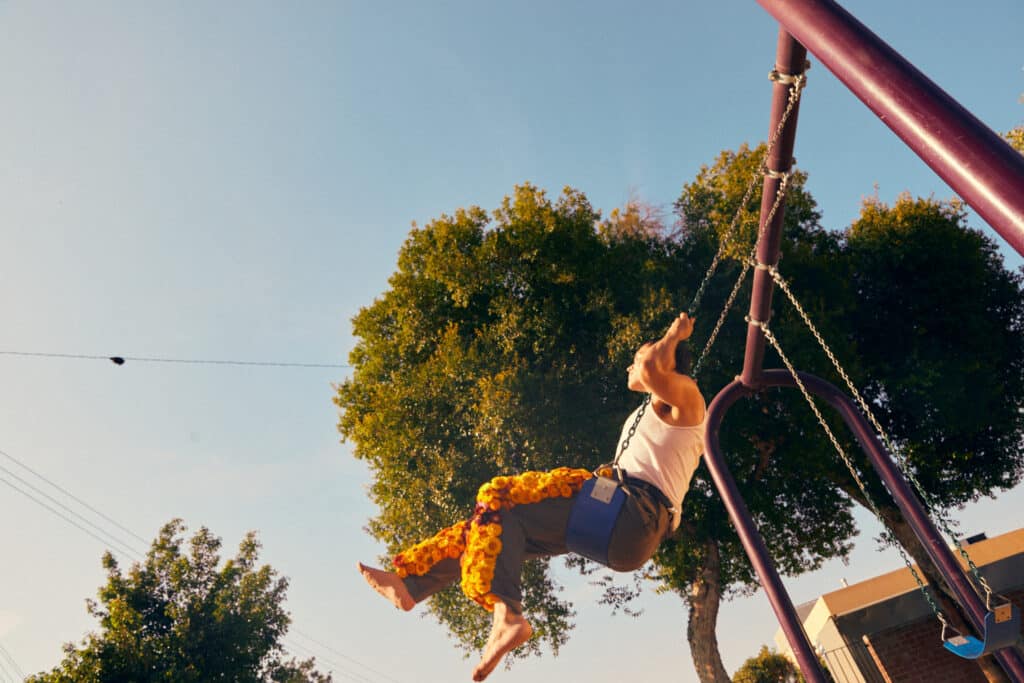
Wie kommst du dazu, mit einer Agentur zusammenzuarbeiten, und was bedeutet das für deine Praxis?
Ich habe meine Agentur zum ersten Mal durch eine Portfolioprüfung kennengelernt, und zwar durch die allererste Portfolioprüfung, die ich als Freiberufler gemacht habe. Ich war erst seit drei Monaten freiberuflich tätig und habe die Portfoliobewertungen für das Palm Springs Photo Festival gemacht. Damals hatte ich nicht die Absicht, einen Vertreter zu treffen, weil ich wusste, dass ich noch nicht an dem Punkt war, an dem es soweit war. Sie vermittelten mich an einen Vertreter von Apostrophe RepsIhr Name ist Lauren - Lauren ist immer noch da, ich liebe Lauren. Wir trafen uns und sie war von meiner Arbeit begeistert und sagte: "Hey, ich würde dich gerne Kelly vorstellen, der Apostrophe gehört, damit sie dich kennenlernen kann." Ein oder zwei Wochen nach der Palm Springs Review traf ich Kelly und Lauren per Zoom und wir blieben in Kontakt.
Später sah ich, dass sie ihre AMP-Programmmit dem Ziel, BIPOC-Fotografen und Nachwuchsfotografen zu fördern. Es ist ein Mentorenprogramm, das Fotografen helfen soll zu verstehen, wie die kommerzielle Welt funktioniert. Ich bewarb mich also, wurde in das Programm aufgenommen und nahm an dem Programm teil - und das baute die Beziehung zu Apostrophe weiter aus, denn ich sah sie jede Woche in unserem virtuellen Klassenzimmer. Sie fingen an, mich ihren Kunden für kleinere Aufträge zu empfehlen, und ich achtete darauf, so gut wie möglich zu arbeiten, weil ich wusste, dass das auf mich zurückfallen würde und wie ich an einem kommerziellen Projekt arbeiten könnte. Im Laufe von drei Jahren wuchs diese Beziehung, bis sie mich schließlich baten, in ihren Dienstplan aufgenommen zu werden.
Ich liebe es, mit Apostrophe zu arbeiten - es ist meine Traumagentur. Sie wird von Frauen geführt, was ich für einen frischen Wind halte. Sie kümmern sich wirklich um ihre Künstlerinnen und Künstler, sie drücken uns die Daumen und versuchen, uns zu helfen, zu wachsen. Ich bin sehr dankbar, dass ich sie auf Anhieb getroffen habe. Nachdem ich ein paar Jahre lang gelernt hatte, wie ich als Freiberuflerin arbeite, mein Geschäft führe und kommerzielle Aufträge annehme, war ich bereit für den nächsten Schritt, nämlich einen Vertreter zu bekommen.
Zum Glück hatte ich diese Beziehung aufgebaut. Du pflanzt Samen - und wenn du Samen pflanzt, bekommst du den Baum nicht über Nacht, er erscheint nicht am nächsten Tag, Bäume wachsen über Jahre. Es geht darum, Geduld und Vertrauen in den Prozess zu haben. Manchmal hört es sich beängstigend an, wenn man denkt: "Oh, mein Gott, du hast drei Jahre gebraucht, um diese Beziehung aufzubauen." Die Realität ist, dass drei Jahre vergangen sind und es besser war, diese Zeit und Mühe in etwas zu investieren, als zu denken. "Ich will jetzt etwas."
Es ist schön, diese Partnerschaft zu haben, jemanden, der dich unterstützt und dich bei jedem Job anfeuert, weil du weißt, dass du ein Team von Leuten hast, die dir den Rücken freihalten und dir hilfreiche Tipps geben. Die Vertretung eines Künstlers verleiht mir auch einen Hauch von Professionalität - ich bin eine junge farbige Frau und manchmal gehen die Leute davon aus, wie viel Erfahrung ich habe, also ist die Vertretung eines Künstlers ein weiteres Instrument, das mir hilft, das Vertrauen potenzieller Kunden zu gewinnen. Sie wissen, dass Apostrophe mich überprüft hat, und sie können mir vertrauen.
Gleichzeitig ist es aber nicht so, dass ich mich darauf verlasse, dass sie meine Karriere vorantreiben, während ich mich zurücklehne und nichts tue. Es ist nicht ohne Grund eine Partnerschaft - ich arbeite wirklich hart daran, mich zu vernetzen, mich zu vermarkten und auch Arbeit zu schaffen. Das Wichtigste, was ich tun kann, ist, Arbeit zu schaffen und sie auch wirklich zu schaffen.
Wie hat sich die Nutzung von Format auf deine Karriere als Freiberufler ausgewirkt?
Ich nutze Format schon seit langem für mein Portfolio - seit über fünf Jahren. Was mir daran gefällt, ist, dass es sich auf Fotos konzentriert, mit Vorlagen, die sich um Fotografie drehen. Es macht es mir wirklich leicht, meine Arbeit schön zu präsentieren - und weil es so einfach zu bedienen ist, kann ich mein Portfolio ständig aktualisieren, ohne das Gefühl zu haben, dass es ein riesiges Unterfangen ist. Ich lade einfach Dinge hoch, die dann in meinen Portfolios gut aussehen. Format hat es für mich zu einem nahtlosen Prozess gemacht.
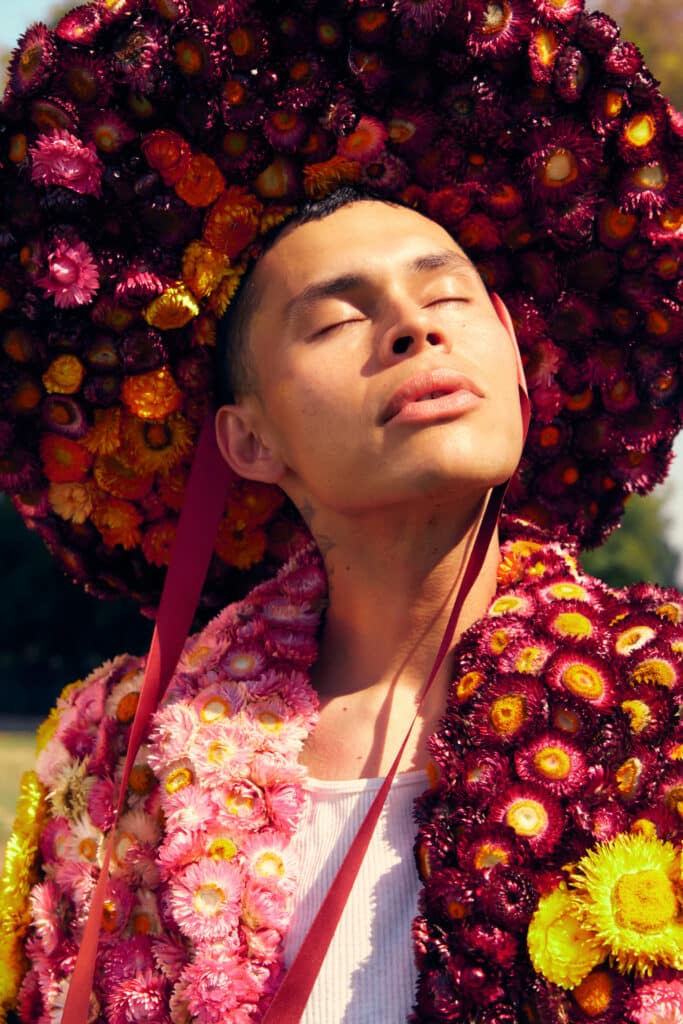
Hast du irgendwelche bevorstehenden Projekte, die du mit uns teilen kannst?
Ich habe gerade ein persönliches Projekt geteilt, über das ich sehr gerne spreche, weil ich schon so lange an der Bearbeitung des Filmmaterials und der Farbkorrektur der Fotos gearbeitet habe. Im Grunde habe ich mit einem Blumenkünstler der einen Anzug, den ich gestohlen hatte, von Kopf bis Fuß mit Blumen bedeckte. Er hat auch einen Hut mit Blumen und einem schönen burgunderroten Band gemacht.
Dann arbeitete ich mit einem Talent namens Pablo-Ich fragte Pablo: "Was sind drei Orte in Los Angeles, die dir viel bedeuten, weil du hier aufgewachsen bist?" Er erzählte mir von einem Park, in dem er mit seinen Freunden und seiner Familie aufgewachsen ist, von einem Strand, an dem er auch oft mit seiner Familie und seinen Freunden war und der ihm viel bedeutet, und von einem dritten Ort.
Ich wollte, dass der Anzug die Liebe darstellt, die du im Inneren für dich selbst hast und wie diese Liebe aus dir herauskommt und dazu führt, dass du generell ein liebevollerer Mensch bist - wie die Liebe aus dir selbst herauskommt und du sie für dich selbst hast.
Es geht also nur darum, dass er an diesen gefühlvollen Orten herumläuft und wirklich glücklich und fröhlich und kraftvoll ist. Ich möchte auch Regie führen, also habe ich mit einem anderen Regisseur zusammengearbeitet. DP für dieses Projekt. Ich habe mich schon sehr darauf gefreut, es mit der Welt zu teilen.
Genieße die Arbeit von Brittany Bravo und lass dich von ihr inspirieren. Online-Portfolio-Website, erstellt mit Formatund folge ihr auf Instagram um über ihre neuesten Projekte auf dem Laufenden zu bleiben.
